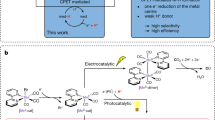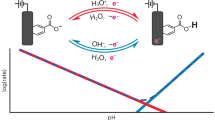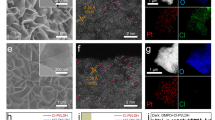Abstract
Metal hydrides are key intermediates in catalytic proton reduction and dihydrogen oxidation. There is currently much interest in appending proton relays near the metal centre to accelerate catalysis by proton-coupled electron transfer (PCET). However, the elementary PCET steps and the role of the proton relays are still poorly understood, and direct kinetic studies of these processes are scarce. Here, we report a series of tungsten hydride complexes as proxy catalysts, with covalently attached pyridyl groups as proton acceptors. The rate of their PCET reaction with external oxidants is increased by several orders of magnitude compared to that of the analogous systems with external pyridine on account of facilitated proton transfer. Moreover, the mechanism of the PCET reaction is altered by the appended bases. A unique feature is that the reaction can be tuned to follow three distinct PCET mechanisms—electron-first, proton-first or a concerted reaction—with very different sensitivities to oxidant and base strength. Such knowledge is crucial for rational improvements of solar fuel catalysts.
This is a preview of subscription content, access via your institution
Access options
Access Nature and 54 other Nature Portfolio journals
Get Nature+, our best-value online-access subscription
$29.99 / 30 days
cancel any time
Subscribe to this journal
Receive 12 print issues and online access
$259.00 per year
only $21.58 per issue
Buy this article
- Purchase on Springer Link
- Instant access to full article PDF
Prices may be subject to local taxes which are calculated during checkout





Similar content being viewed by others
References
Gray, H. B. Powering the planet with solar fuel. Nat. Chem. 1, 7 (2009).
Graetzel, M. Artificial photosynthesis: water cleavage into hydrogen and oxygen by visible light. Acc. Chem. Res. 14, 376–384 (1981).
Gust, D., Moore, T. A. & Moore, A. L. Solar fuels via artificial photosynthesis. Acc. Chem. Res. 42, 1890–1898 (2009).
Montoya, J. H. et al. Materials for solar fuels and chemicals. Nat. Mater. 16, 70–81 (2017).
Faunce, T. A. et al. Energy and environment policy case for a global project on artificial photosynthesis. Energy Environ. Sci. 6, 695–698 (2013).
Steele, B. C. H. & Heinzel, A. Materials for fuel-cell technologies. Nature 414, 345–352 (2001).
Debe, M. K. Electrocatalyst approaches and challenges for automotive fuel cells. Nature 486, 43–51 (2012).
Dempsey, J. L., Winkler, J. R. & Gray, H. B. Proton-coupled electron flow in protein redox machines. Chem. Rev. 110, 7024–7039 (2010).
Hay, S. & Scrutton, N. S. Good vibrations in enzyme-catalysed reactions. Nat. Chem. 4, 161–168 (2012).
Dogutan, D. K., McGuire, R. & Nocera, D. G. Electocatalytic water oxidation by cobalt(iii) hangman β-octafluoro corroles. J. Am. Chem. Soc. 133, 9178–9180 (2011).
Bediako, D. K. et al. Role of pendant proton relays and proton-coupled electron transfer on the hydrogen evolution reaction by nickel hangman porphyrins. Proc. Natl Acad. Sci. USA 111, 15001–15006 (2014).
Helm, M. L., Stewart, M. P., Bullock, R. M., DuBois, M. R. & DuBois, D. L. A synthetic nickel electrocatalyst with a turnover frequency above 100,000 s−1 for H2 production. Science 333, 863–866 (2011).
O’Hagan, M. et al. Proton delivery and removal in [Ni(PR 2NR′ 2)2]2+ hydrogen production and oxidation catalysts. J. Am. Chem. Soc. 134, 19409–19424 (2012).
Zhang, S., Appel, A. M. & Bullock, R. M. Reversible heterolytic cleavage of the H–H bond by molybdenum complexes: controlling the dynamics of exchange between proton and hydride. J. Am. Chem. Soc. 139, 7376–7387 (2017).
Costentin, C., Passard, G., Robert, M. & Savéant, J.-M. Pendant acid–base groups in molecular catalysts: H-bond promoters or proton relays? Mechanisms of the conversion of CO2 to CO by electrogenerated iron(0)porphyrins bearing prepositioned phenol functionalities. J. Am. Chem. Soc. 136, 11821–11829 (2014).
Lilio, A. M. et al. Incorporation of pendant bases into Rh(diphosphine)2 complexes: synthesis, thermodynamic studies, and catalytic CO2 hydrogenation activity of [Rh(P2N2)2]+ complexes. J. Am. Chem. Soc. 137, 8251–8260 (2015).
Seu, C. S., Appel, A. M., Doud, M. D., DuBois, D. L. & Kubiak, C. P. Formate oxidation via β-deprotonation in [Ni(PR 2NR′ 2)2(CH3CN)]2+ complexes. Energy Environ. Sci. 5, 6480–6490 (2012).
Roy, S. et al. Molecular cobalt complexes with pendant amines for selective electrocatalytic reduction of carbon dioxide to formic acid. J. Am. Chem. Soc. 139, 3685–3696 (2017).
Costentin, C., Drouet, S., Robert, M. & Savéant, J.-M. A local proton source enhances CO2 electroreduction to CO by a molecular Fe catalyst. Science 338, 90–94 (2012).
Pegis, M. L. et al. Homogenous electrocatalytic oxygen reduction rates correlate with reaction overpotential in acidic organic solutions. ACS Cent. Sci. 2, 850–856 (2016).
Auer, B., Fernandez, L. E. & Hammes-Schiffer, S. Theoretical analysis of proton relays in electrochemical proton-coupled electron transfer. J. Am. Chem. Soc. 133, 8282–8292 (2011).
Bourrez, M., Steinmetz, R., Ott, S., Gloaguen, F. & Hammarström, L. Concerted proton-coupled electron transfer from a metal–hydride complex. Nat. Chem. 7, 140–145 (2015).
Elgrishi, N., Kurtz, D. A. & Dempsey, J. L. Reaction parameters influencing cobalt hydride formation kinetics: implications for benchmarking H2-evolution catalysts. J. Am. Chem. Soc. 139, 239–244 (2017).
Norskov, J. K., Bligaard, T., Rossmeisl, J. & Christensen, C. H. Towards the computational design of solid catalysts. Nat. Chem. 1, 37–46 (2009).
Olsson, M. H. M., Siegbahn, P. E. M. & Warshel, A. Simulating large nuclear quantum mechanical corrections in hydrogen atom transfer reactions in metalloenzymes. J. Biol. Inorg. Chem. 9, 96–99 (2004).
Hammes-Schiffer, S. & Stuchebrukhov, A. A. Theory of coupled electron and proton transfer reactions. Chem. Rev. 110, 6939–6960 (2010).
Rhile, I. J. & Mayer, J. M. One-electron oxidation of a hydrogen-bonded phenol occurs by concerted proton-coupled electron transfer. J. Am. Chem. Soc. 126, 12718–12719 (2004).
Markle, T. F., Rhile, I. J. & Mayer, J. M. Kinetic effects of increased proton transfer distance on proton-coupled oxidations of phenol-amines. J. Am. Chem. Soc. 133, 17341–17352 (2011).
Zhang, M.-T., Irebo, T., Johansson, O. & Hammarström, L. Proton-coupled electron transfer from tyrosine: a strong rate dependence on intramolecular proton transfer distance. J. Am. Chem. Soc. 133, 13224–13227 (2011).
Glover, S. D., Parada, G. A., Markle, T. F., Ott, S. & Hammarström, L. Isolating the effects of the proton tunneling distance on proton-coupled electron transfer in a series of homologous tyrosine-base model compounds. J. Am. Chem. Soc. 139, 2090–2101 (2017).
Belkova, N. V., Epstein, L. M., Filippov, O. A. & Shubina, E. S. Hydrogen and dihydrogen bonds in the reactions of metal hydrides. Chem. Rev. 116, 8545–8587 (2016).
Eigen, M. Proton transfer, acid-base catalysis, and enzymatic hydrolysis. Angew. Chem. Int. Ed. 3, 1–19 (1964).
Marcus, R. A. & Sutin, N. Electron transfers in chemistry and biology. Biochim. Biophys. Acta - Rev. Bioenerg. 811, 265–322 (1985).
Irebo, T., Zhang, M.-T., Markle, T. F., Scott, A. M. & Hammarström, L. Spanning four mechanistic regions of intramolecular proton-coupled electron transfer in a Ru(bpy)3 2+–tyrosine complex. J. Am. Chem. Soc. 134, 16247–16254 (2012).
Tilset, M. & Parker, V. D. Solution homolytic bond dissociation energies of organotransition-metal hydrides. J. Am. Chem. Soc. 111, 6711–6717 (1989).
Ryan, O. B., Tilset, M. & Parker, V. D. Chemical and electrochemical oxidation of group 6 cyclopentadienylmetal hydrides. First estimates of 17-electron metal–hydride cation-radical thermodynamic acidities and their decomposition of 17-electron neutral radicals. J. Am. Chem. Soc. 112, 2618–2626 (1990).
Meyer, T. J. & Caspar, J. V. Photochemistry of metal-metal bonds. Chem. Rev. 85, 187–218 (1985).
Parker, V. D., Handoo, K. L., Roness, F. & Tilset, M. Electrode potentials and the thermodynamics of isodesmic reactions. J. Am. Chem. Soc. 113, 7493–7498 (1991).
Jordan, R. F. & Norton, J. R. Kinetic and thermodynamic acidity of hydrido transition-metal complexes. 1. Periodic trends in Group VI complexes and substituent effects in osmium complexes. J. Am. Chem. Soc. 104, 1255–1263 (1982).
Edidin, R. T., Sullivan, J. M. & Norton, J. R. Kinetic and thermodynamic acidity of hydrido transition-metal complexes. 4. Kinetic acidities toward aniline and their use in identifying proton-transfer mechanisms. J. Am. Chem. Soc. 109, 3945–3953 (1987).
Kaljurand, I. et al. Extension of the self-consistent spectrophotometric basicity scale in acetonitrile to a full span of 28 pK a units: unification of different basicity scales. J. Org. Chem. 70, 1019–1028 (2005).
Markle, T. F., Tronic, T. A., DiPasquale, A. G., Kaminsky, W. & Mayer, J. M. Effect of basic site substituents on concerted proton–electron transfer in hydrogen-bonded pyridyl–phenols. J. Phys. Chem. A. 116, 12249–12259 (2012).
Rhile, I. J. et al. Concerted proton–electron transfer in the oxidation of hydrogen-bonded phenols. J. Am. Chem. Soc. 128, 6075–6088 (2006).
Acknowledgements
T.L. acknowledges S.D. Glover, R. Fernandez-Teran and S. Wang for fruitful discussions. This work was supported by The Swedish Research Council (grant no. 2016-04271) and The Knut and Alice Wallenberg Foundation (grant no. 2011.0067). Correspondence and requests for materials should be addressed to L.H.
Author information
Authors and Affiliations
Contributions
T.L., S.O. and L.H. planned the research and prepared the manuscript. T.L. performed the experiments. R.L. supervised the electrochemistry experiments. A.O. conducted the X-ray diffraction analyses and refined structures. M.G. and M.L. performed theoretical calculations and analyses. All authors edited and reviewed the manuscript in the context of their contributions.
Corresponding author
Ethics declarations
Competing interests
The authors declare no competing interests.
Additional information
Publisher’s note: Springer Nature remains neutral with regard to jurisdictional claims in published maps and institutional affiliations.
Supplementary information
Supplementary information
Supplementary Methods, Supplementary Figures 1–46, Supplementary Tables 1–7, Supplementary Experimental Data, Supplementary Theoretical Data
Crystallographic data
CIF for compound 3a; CCDC reference: 1552847
Crystallographic data
CIF for compound 3d; CCDC reference: 1552848
Crystallographic data
CIF for compound 3e; CCDC reference: 1552849
Rights and permissions
About this article
Cite this article
Liu, T., Guo, M., Orthaber, A. et al. Accelerating proton-coupled electron transfer of metal hydrides in catalyst model reactions. Nature Chem 10, 881–887 (2018). https://doi.org/10.1038/s41557-018-0076-x
Received:
Accepted:
Published:
Issue Date:
DOI: https://doi.org/10.1038/s41557-018-0076-x
This article is cited by
-
Artificial Cu-Ni catalyst towards highly efficient nitrate-to-ammonia conversion
Science China Materials (2023)
-
Regulation of the electrocatalytic nitrogen cycle based on sequential proton–electron transfer
Nature Catalysis (2022)
-
Boosting thermo-photocatalytic CO2 conversion activity by using photosynthesis-inspired electron-proton-transfer mediators
Nature Communications (2021)
-
Ab initio adiabatic study of the AgH system
Scientific Reports (2021)
-
Tuning proton-coupled electron transfer by crystal orientation for efficient water oxidization on double perovskite oxides
Nature Communications (2020)



